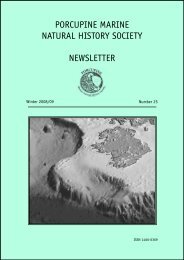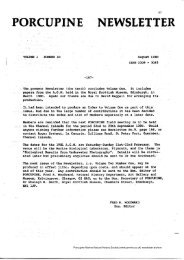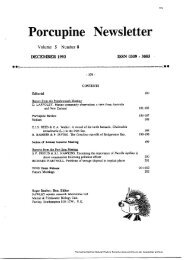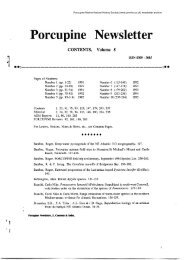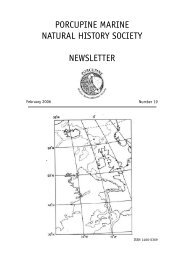PORCUPINE MARINE NATURAL HISTORY SOCIETY NEWSLETTER
PORCUPINE MARINE NATURAL HISTORY SOCIETY NEWSLETTER
PORCUPINE MARINE NATURAL HISTORY SOCIETY NEWSLETTER
Create successful ePaper yourself
Turn your PDF publications into a flip-book with our unique Google optimized e-Paper software.
<strong>PORCUPINE</strong> PROBLEMS<br />
24<br />
Information Requests and Observations<br />
Unusual records from Seasearch<br />
2007 data<br />
Chris Wood, National Seasearch Coordinator,<br />
chris@seasearch.org.uk<br />
Despite less than perfect diving weather,<br />
2007 was the most productive year ever for<br />
Seasearch records with 1,332 records received.<br />
We also had the highest number of Survey<br />
Forms, 453, and, since these normally contain<br />
multiple habitat descriptions and species lists,<br />
it represents a huge volume of data from all<br />
over the UK, with some also from Ireland and<br />
the Channel Islands.<br />
The data contains a number of interesting<br />
sightings of things either apparently new to<br />
our waters or new to the area where they were<br />
found. All of the sightings below are backed<br />
up by photographic records. Most are of mobile<br />
species and whether they represent one-off<br />
occurrences or shifts in distribution only time<br />
will tell.<br />
All of the Seasearch data can be accessed<br />
through the National Biodiversity Network<br />
website, www.searchnbn.net There is also a<br />
downloadable Annual Report for 2007 and 15<br />
area summaries on the Seasearch website www.<br />
seasearch.org.uk .<br />
Periclimenes sagittifer, anemone prawn.<br />
Commonly found with snakelocks anemones<br />
in the Channel Islands and further south, the<br />
2007 Seasearch record is the first on the NBN<br />
from the north side of the English Channel,<br />
astonishingly from Swanage Pier - (see p21)<br />
Alpheus macrocheles, snapping prawn.<br />
Another southerly species with the few<br />
previous NBN records from well offshore. A<br />
cryptic species so the record from Lyme Bay<br />
may be more about knowing what to listen for<br />
and how to find it!<br />
Palinurus elephas, crawfish. A recent<br />
PMNHS Newsletter No.24 Summer 2008<br />
addition to the BAP species list and normally<br />
found on west coasts. The Seasearch record in<br />
2007 from the Farne Islands is the first on the<br />
NBN from anywhere on the North Sea coast of<br />
England or southern Scotland.<br />
Photo - Christine Norris<br />
Parablennius ruber, red or Portuguese<br />
blenny. Recently recorded from a number of<br />
exposed westerly locations in Scotland, Ireland<br />
and Isles of Scilly. Two Seasearch records<br />
in 2007 from different sites in the Isles of<br />
Scilly.<br />
Parablennius gattorugine, tompot blenny.<br />
A common species on southerly and westerly<br />
coasts, the record from North Norfolk is the<br />
first record for Eastern England south of<br />
Sunderland.<br />
Parablennius rouxi, striped blenny.<br />
Previously recorded from the Mediterranean<br />
and Atlantic coast of Portugal, the Seasearch<br />
record from Bigbury Bay, Devon is the first<br />
for the UK.<br />
In addition to these mobile species,<br />
Seasearch divers also recorded a number of<br />
nationally scarce and rare species in new<br />
places, including a new site for sunset cupcorals,<br />
Leptopsammia pruvoti, in the Isles of<br />
Scilly and new sites for the pink soft coral<br />
Alcyonium hibernicum, in Devon.



